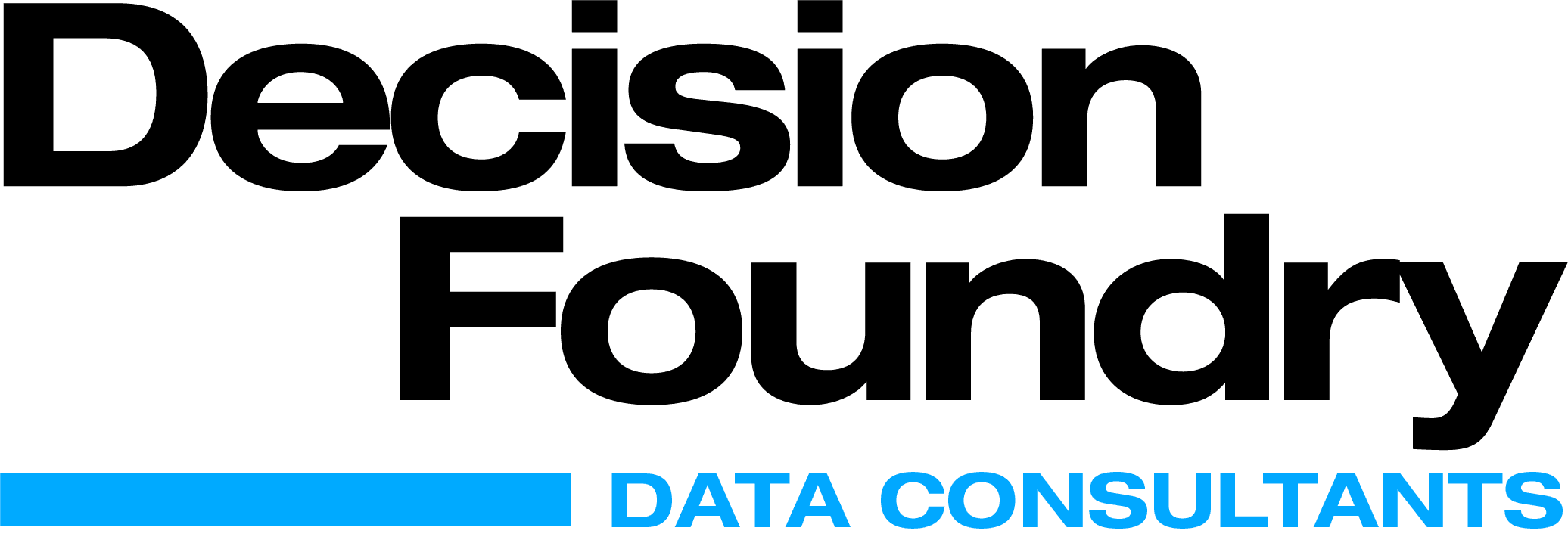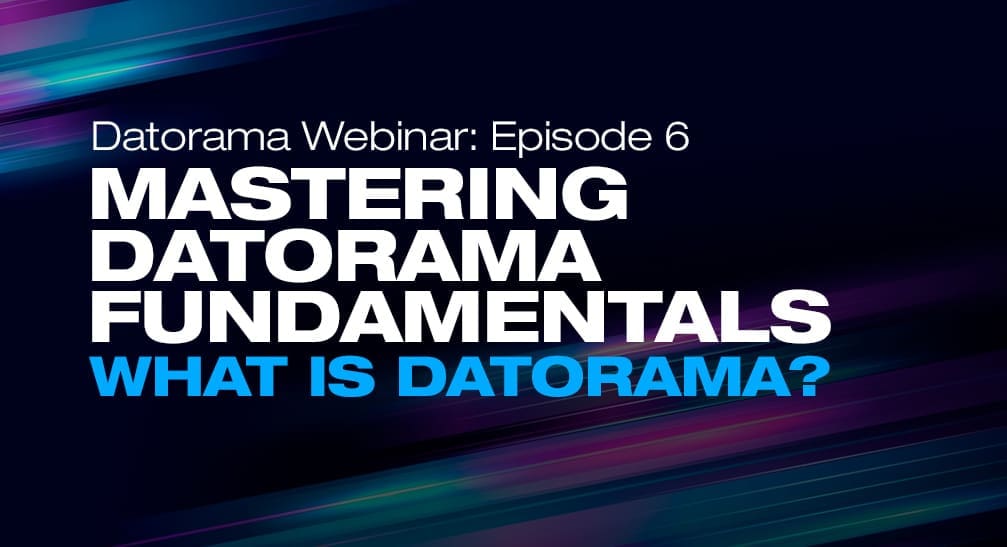What You Should Know About the Platform
Let’s drop the hyperbole and review some of the platform’s most recognized and useful capabilities. Along the way, we’ll answer many of the most commonly asked questions.
Overview
Salesforce’s Marketing Cloud Intelligence (FKA Datorama) is an analytics tool used to integrate, and visualize marketing performance data of all types. It is easy enough for the analytically driven Marketer to use, but familiar enough for seasoned Analysts looking to connect data to traditional BI tools, like Tableau.
Flexible SaaS with Customization
Although it is SaaS, Datorama is surprisingly flexible. It can be used as a stand-alone unit supporting data storage, data modeling, ETL and visualization or used in conjunction with potentially competitive platforms like Azure Databricks or Looker. It serves a number of common data use cases, but its primary focus is Performance Marketing.
Marketing Cloud Intelligence is often confused as a traditional Business Intelligence, Analytics or Data Visualization platform, but is more accurately defined by data management. If you are considering a future purchase of the platform, start with Getting to Know Marketing Cloud Intelligence for the uninitiated or browse our video walkthrough of the MCI platform.
What Is Datorama called now?
Marketing Cloud Intelligence is now the name of the Datorama platform. The name change was suggested in early 2022, but re-branding efforts have only recently taken hold. Only the packaging is different, but the features and capabilities remain the same for now…
A Platform Created for the Agency? Well, Maybe.
Its roots are from the ad technology space, in fact, the largest media holding companies in the U.S. use it to support automated, client and agency side reporting. A typical use case for agencies is to use a premium feature called, Media Cost Center where media plan data is connected to delivered impressions. However, Marketing Cloud Intelligence works well for retailers, publishers, gaming, pharma, automotive, and device makers, too.
Who Were the Founders?
An Israeli-based technology firm that was founded in 2012. For many years, it remained independently owned by Ran Sarig, Efi Cohen and Katrin Ribant. This small company of dedicated technologists grew rapidly and became a favorable option for delivering automated, client-facing, media performance reports. As of 2018, Datorama was purchased by Salesforce and is now a part of the Marketing Cloud family of platforms, including Account, Engagement, Personalization and Data Cloud.
Where did the Founders Go?
Unfortunately as of February 2, 2023 the original founders and core engineering teams have moved on. This likely signals a different direction for the platform over the next several years and if the name change holds true, then we have a sense for what happens next. For now, Intelligence remains a viable, stand-alone data management tool for the price. Want to learn more about the history of the platform and the creative ways the platform can be customized, join Datorama Experts.
Data Onboarding and Connectivity that Works
The platform with the strange name was pronounced, “day-tah-rah-mah”. What does it do? For starters, it has a solid set of robust and reliable data connectors as well as easy-to-use retrieval mechanisms for exporting and ingesting data from popular, and often competitive data management platforms such as SAP Hana, AWS, Oracle, Vertica, and SQL server.
Can Event Level Data Be Ingested?
Detailed, event level data can be ingested, but “Intelligence” is at its best when it focuses on the ingestion of messy, aggregated data. See our video on onboarding data for a 20 minute walkthrough.
Is the Price Nice? Maybe.
The commercials are largely driven by data row consumption and “seats”. At higher volumes, the product can become cost prohibitive. For progressive SMBs this solution can work, but “Intelligence” may be a better value platform for middle market and enterprises. Data row capacity has historically been a messaging problem for Salesforce, but more recently, storage can be extended due to a premium feature known as Data Lake, giving Marketers the opportunity to ingest highly granular information from log files, creative dimensions, clickstream, keyword details and bid level activities without the proportional pricing hit to your contract. This solution may be supplanted by Salesforce Data Cloud, formerly known as CDP. See your SF AE for details.
Six Critical Marketing Data Use Cases Datorama Solves
What makes Marketing Cloud Intelligence useful for organizations working across Martech is its flexible support for rapidly onboarding existing and emerging data platforms including, ad servers, demand side platforms, SSPs, site analytics, and points-of-sale systems.
Datorama is a channel and partner agnostic platform that can help marketing organizations in 6 specific ways:
- Build a single source of all data, at enterprise scale — augmented with Data Lake and CDP
- Natively integrate with other Salesforce Cloud platforms such as Marketing, Service, Sales and Pardot using available API connectors
- Connect and harmonize (structured and unstructured) data across third-party data platforms
- Draw insights from data and action it through alerts and customizable publishing tools
- Take advantage of powerful data integration capabilities and tackle persistent areas such as pacing, goal setting, marrying 1st to 3rd party data platforms, and end of month billing challenges through Salesforce and Total Connect.
- Produce informative dashboards through Data Canvas which supports the integration of javascript libraries such as D3, High Charts, Chart.js, and other popular frameworks. You can produce basic dashboards in the platform, as well as award-winning Datorama Dashboard examples with highly polished user interfaces. Actual client deliverables are on display, below.
Top Six Competitors
Its primary competitors are Domo, Adverity, NinjaCat, Improvado, Looker, PowerBI and Google Data Studio. Besides the 3rd party competitors, our experience is that the biggest competitors are often excel and other homegrown, data analytics platforms. With patience, MCI scales to support the primary marketing performance data use cases; onboarding, integration, visualization, harmonization, reporting, and alerts in ways other competitors either don’t or can’t do easily.
What is Datorama Reports in Marketing Cloud?
Salesforce Marketing Cloud offers an efficient method for creating, viewing, and sharing campaign level, email campaign performance and Journey Builder insights at no additional cost to corporate and enterprise level clients. A solid solution for Marketers seeking quick access to delivery, engagement, and journey metrics within the Marketing Cloud UI, as well as within a helpful pivot table for additional analysis. There’s a similar solution called Reports Advanced, which is a premium upgrade for Marketing Cloud offering more features, functionality, and analytics. However, the Advanced upgrade comes with an additional cost. See your Salesforce AE for details.
What’s the difference between Tableau and Datorama?
Salesforce continues to make strategically placed bets by acquiring analytical partners and technologies. Tableau and Datorama are great examples of this, but why would Salesforce purchase both? At the core, Marketing Cloud Intelligence is a flexible SaaS, data management platform and Tableau is undeniably the markets best visualization, and data exploration tool. Yes, there are nuances and overlaps between the platforms as they serve similar audiences but with very different use cases. Which use case is right for you? Why choose? For now, use them both as applicable.
What Are the Top Buyer Segments and Industries
The most common buyer segments supported are marketers and advertisers. The top industries (by volume) include communications, media, and technology with a particular emphasis on mid to large agencies (performance marketing) and media holding companies. However, the data management capabilities serve Health and Life Sciences, Financial Services, Manufacturing, Automotive, Retail and Publishers.
The platform allows advertisers, agencies and publishers to pull data from a myriad of data sources, blend and create custom KPIs, and quickly build informative dashboards to analyze and draw insights.
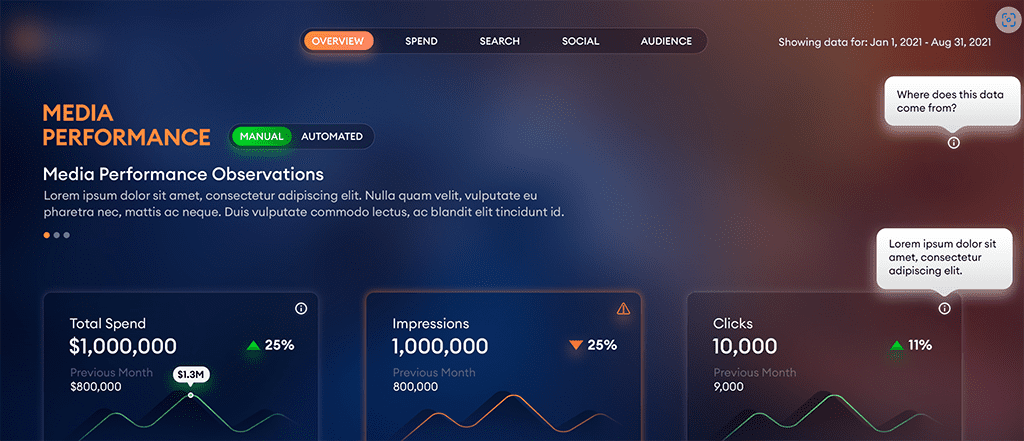
6 Data Ingestion Methods
Its most impressive feature is arguably the Data Model which becomes evident the first time any data source is onboarded. Datorama now supports 6 primary methods of data ingestion:
- API connectors – supports various native APIs for a wide range of platforms
- Total Connect – For the data sources that do not have API support, data can be ingested as a flat-file.
- Custom Connectors – provides the ability for developers to use scripting languages for building custom API connections
- Direct Connect – a paid option that allows you to retrieve data directly from popular, external data providers, without having to store the data in Marketing Cloud Intelligence.
- Data Pipelines easily exports your data into a data warehouse, report or even Tableau.
- Data Lake – offering the ability to onboard billions of data rows and data granularity at the keyword, geo, event, log and visitor levels, to name a few
Through Machine Learning, the platform understands an array of common data types and instantly suggests possible relationships among data entities greatly speeding up historical approaches of mapping using fuzzy logic, pattern recognition and clever, albeit cumbersome look-ups. As of 3/10/2023, Marketing Cloud Intelligence has 176 data connectors.
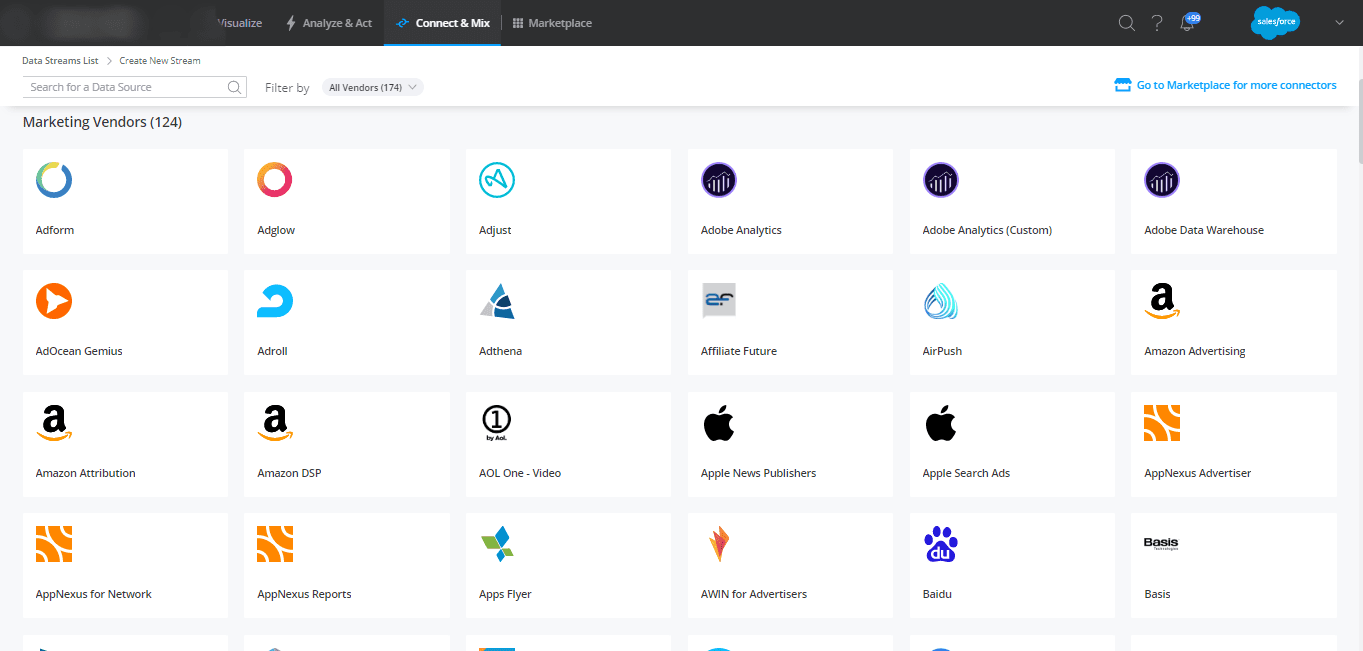
Marketing Cloud Intelligence provides harmonization and data blending capabilities to assist analysts with quickly pairing parent-to-child data relationships, custom classification based on external files, calculation types, or common naming patterns.
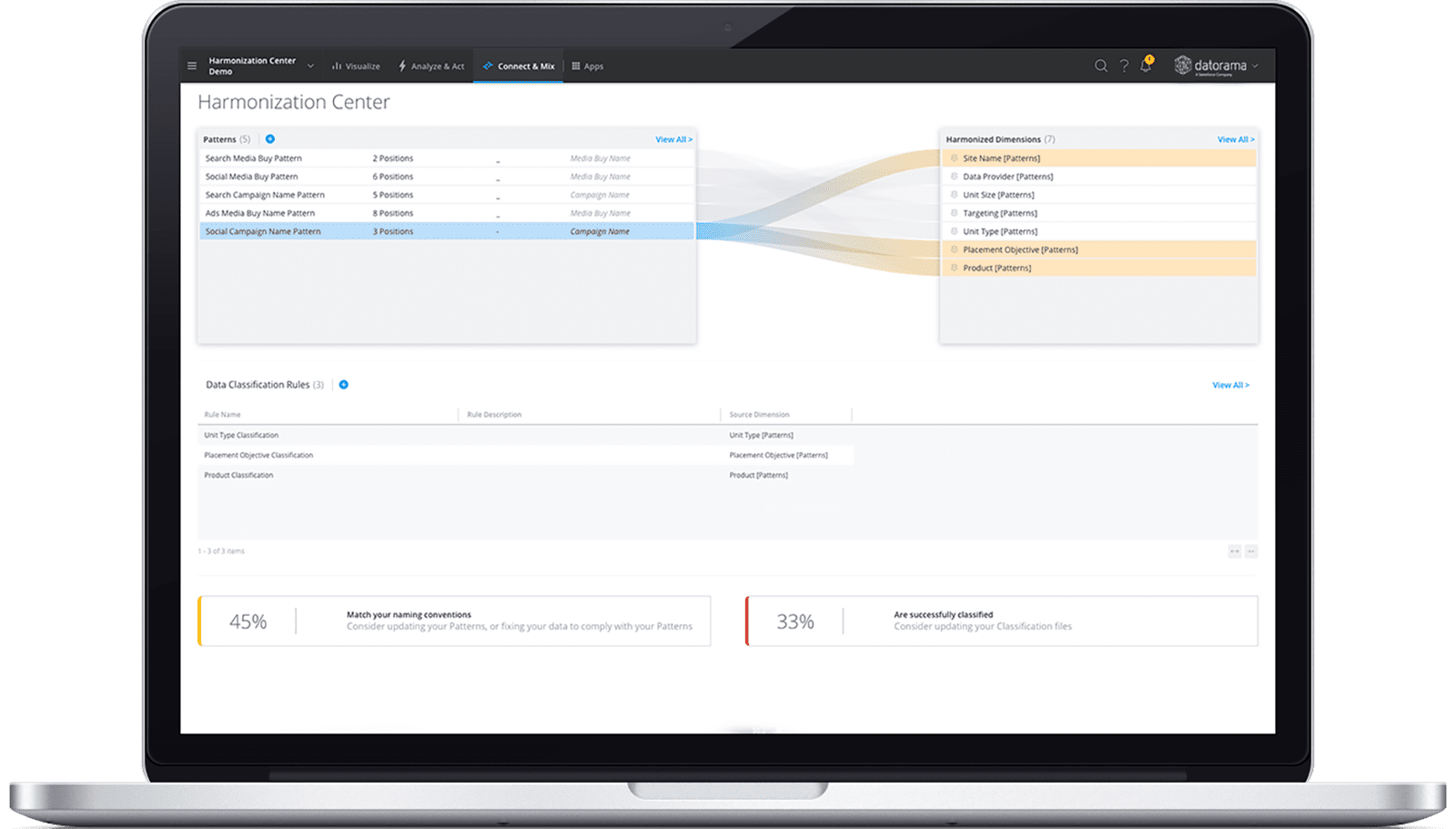
Is Datorama a CDP?
Marketing Cloud Intelligence is a solid platform, but it isn’t a Customer Data Platform (CDP), and beyond the capabilities of unifying performance data and data orchestration, the comparison isn’t appropriate. It’s true that customer level details can be ingested into MCI, but often with a significant impact to data row consumption rates. Consider Salesforce Data Cloud. Check your contract before proceeding.
Marketing Cloud Intelligence was designed to ingest aggregated marketing performance data. Conversely, CDPs were developed to ingest customer or user level detailed data. MCI does not focus on audience activation, identity resolution, segmentation, personalization, or the customer journey. These are hallmark features often associated with a CDP, therefore, by our definition, MCI is not one. However, it could be argued that if you review the totality of the Marketing Cloud ecosystem, all of the elements of CDP do exist, but not in MCI, alone. Salesforce has a CDP and it does integrate with MCI to extend this growing use case. If CDP becomes Salesforce’s universal solution for data ingestion and activation, what does that potentially mean for MCI?
Data Lake Expands Row Count Flexibility without a Premium Price Point
Data Lake is a premium, paid feature designed for ingesting raw granular data. This granularity requirement can allow Marketers to ingest hundreds of millions or even billions of rows without artificially inflating the cost associated with data row usage. Much to the delight of long time users, when Data Lake is purchased, usage and pricing does not apply by the row count but rather by terabytes of storage space. You can also think of Data Lake as cold storage. Some examples of data types that work best with data lake data streams are keyword level data, bid activity, event level data, and granular geodata similar to what you might see in large media agencies or as required inputs for Mixed Media Models. You should expect to pay about 20% of the total cost of your license to take advantage of Data Lake, but it may be worth it, depending on your needs.
How Often is the Platform Updated?
Frequent product release cycles matter. The platform is updated quarterly, focused around enhancements around Analyze and Act, Visualization, Connect and Unify and Marketplace Apps. In March of 2023, the Intelligence community received a number of significant enhancements to the platform. Browse the official Summer ’23 release notes.
How to monitor data row usage in Marketing Cloud Intelligence
Since Marketing Cloud Intelligence often prices its software based on tiers and data row counts, it’s important that you occasionally monitor your progression, particularly if you intend to onboard granular data. For example, DMA or keyword level breakdowns. To verify your row count, consider the following.
At the admin role, you can see your overall and current row usage at both the account and workspace levels. Keep in mind that row usage refreshes every hour.
To monitor row usage:
1) To the right of the navigation bar, click the dropdown arrow, and click the Account Settings gear icon.
2) In the account menu, select Data Rows Usage.
3) View live row usage, and a breakdown of workspaces by row usage.
There are two system measurements reflect the total row count of a data stream in a workspace:
- Data Stream Effective Total Rows
- Data Stream Total Rows
SOURCE: https://help.salesforce.com/s/articleView?id=sf.dato_getstarted_manage_data_usage.htm&type=5
How much does the license cost?
Considering the overall capabilities of the platform it is relatively affordable when compared to similarly positioned competitors. Pricing can start as low as $36,000 per year, but there are always deals to be made, particularly at the end of a quarter. See your Salesforce Account Executive for details.
Where’s the Datorama Login?
Salesforce has moved this around a bit, but you can find the login by going to https://platform.datorama.com/login. Type in your username and password to proceed, then bookmark the location in your browser.
How Can I Learn Datorama?
If you are new to the platform or just interested in improving your skills, we recommend you login to the platform and visit the Trailblazer community forum. The articles, webinars and videos are essential reading, regardless of your level of experience. If you’d like to get certified, consider receiving some formal training.
Summary: A Formidable Tool for Analytical Data Marketers
Datorama is an affordably priced, data management and visualization platform created for the Analytical Marketer needing tools to onboard and manage marketing performance data. This partnership should continue to meet today’s marketing data challenges with progressive tools and technologies and a strong product and engineering roadmap. Recent Salesforce headlines cast the long term future of the product in doubt, but for now, we remain confident in its staying power.
The Future of Salesforce’s Analytical Data Platform
Marketing Cloud Intelligence is indeed a flexible, AI-driven, data platform that features multiple solutions for the agency and the advertiser, but does it deliver cloud based, Marketing Intelligence as promoted? Salesforce provides a strong response to a fragmented but commoditized data management and visualization ecosystem. Look for it to continue to pair Tableau’s stronger data exploration capabilities with MCI’s data management excellence to shore up the marketplace as well as to strengthen Salesforce’s position in the Analytics space. The immediate challenge is that there are less expensive, but nimble competitors forcing MCI to drop their pricing, further. A race to the bottom rarely works. Beyond the rebranding, it’s possible that the name change could shed light on the future of the platform. My prediction, will the product and engineering group extend integration efforts across the Marketing Cloud ecosystem to bolster utility, or will this analytics tool remain beneficial, but separate, for now? If the continued cost reduction of the license is any indicator, perhaps it’s the latter? Let’s see how Salesforce promotes the features and benefits of MCI, moving forward. Dreamforce 2022 gave us very few answers and plenty of tells. Decision Foundry had a front seat. Were you there? Tell us what you think.
Certified Support Partners
Decision Foundry is a top-tier Salesforce implementation partner providing training and support for non-partner, certification. Our global team of 140+ includes Salesforce Marketing Champions and some of the industry’s leading practitioners in data analytics and visual communication. Ask for a product demo and see our short portfolio of award-winning dashboard examples then, consider us for your next project.
About the Author
Ross Jenkins is the CEO of Decision Foundry, a Salesforce Integration Partner and certified ISV. He is neither an employee of Salesforce nor a shareholder. The views expressed in this article reflect his experience with the Marketing Cloud Intelligence platform over eight years. He is a Salesforce Marketing Champion, and a frequent Analytics conference speaker including the most recent ’22 Dreamforce and Salesforce World Tour D.C ’23 event. Want to know more about Decision Foundry, see us at Salesforce Connections 2023.
